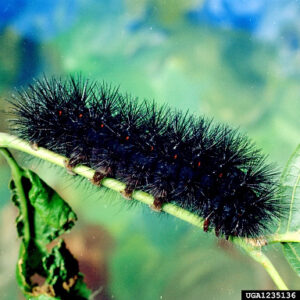
Joys of Yard Clean Up
Submitted December 2021
By Ranger Steve Mueller (8/13/1950 – 6/16/2022)
In early childhood, we “helped dad” with fall leaf clean up. Perhaps he did not consider us help, but he probably enjoyed our joy. We jumped in leaf piles and buried ourselves in leaves. My girls did similar antics. It brought happiness for all.

Hidden among the leaves are wonderful things to be discovered besides buried kids. This week we found a Giant Leopard Moth (Hypercompe scribonia) caterpillar. They are large and stretch up to 3 inches in length. The body is covered with black hairs but hidden under the bristles are red rings circling the body. The caterpillars survive winter as larvae because they contain protective antifreeze in their system. In short north country summers, they may require more than one season to mature and transform to an adult.
When lucky, you might see the adult moth standing on a screen door under a porch light. They are observed infrequently as adults but when they are, it captures one’s attention. White wings are covered with black ring spots centered with white creating little o’s. They are the source for their appropriate name leopard.



Common Wooly Bear (Pyrrharctia isabella) caterpillars are spotted walking yards and driveways each fall. They are seeking places to hibernate. Sometimes they are uncovered when leaves are raked. The caterpillars wander neighborhoods in fall making grand appearances. They bodies are black with a rusty orange/brown band of stiff hairs in the middle section. The width of the band varies with age. As caterpillars outgrow their outer exoskeleton, it must be shed for a larger one. The outer “skin” splits and the caterpillar crawls out. The caterpillar expands its size by filling with air before the new soft skeleton hardens to allow room for growth. It is not rigid like the exoskeleton of adult insects but is leathery. Flexibility allows it to curl and bend when walking and feeding.
People often think the width of the rusty orange band foretells future winter weather conditions. Instead, it indicates the age of the caterpillar. When they age and get a new outer exoskeleton it has a wider orange band. If the growing season is short, the caterpillar will be blacker because it has not molted as many times.
After overwintering, it continues feeding on a variety of plants before making a cocoon where it transforms to an adult moth. This adult Isabella tiger moth has brown wings with a few black spots and a row of black dots on the upside of its abdomen. Like the Giant Leopard Moth, this caterpillar contains glycerol antifreeze allowing it to survive in its winter nature niche.


Warm days continued into fall pulling me to outdoor joys. Garter snakes were seduced by sunshine to locations where their dark bodies lined with lighter stripes blended among layered leaves. A bulky dark brown meadow vole with its short tail ran in front of me and disappeared in the dead vegetation that fell from now naked trees. Maybe it will survive into winter or be eaten by a garter snake, a Red-tailed Hawk, or Barred Owl. A grass ball-like shelter made by the vole might be found while you rake leaves. We leave portions of the yard leaf covered to provide multiple winter animal homes and for leaves to decay to fertilize the soil.
I walked from the yard for a colorful diversion and to rest from yard clean up. Physically, I tire more easily these days and want to simply experience fall colors resting peacefully on the ground instead of waving at me from tree limbs. A Mourning Cloak butterfly flitted nearby where it came into view more than once as I traversed the wooded trail.
I returned to finish the joys of yard clean up that some might refer to as work.
Photos: Bugwood.org
Giant leopard moth caterpillar – Clemson University – USDA Cooperative Extension Slide Series
Giant leopard moth – Negin Almassi, Forest Preserves of Cook County
Giant leopard moth – Clemson University – USDA Cooperative Extension Slide Series
Woolly bear caterpillar – Whitney Cranshaw, Colorado State University Bugwood.org
Isabella tiger moth – Rebekah D. Wallace, University of Georgia
Isabella tiger moths, mounted – Whitney Cranshaw, Colorado State University
